As part of a positive transition, it is important to show the child that we are thinking of them, holding them in mind and giving them permission to make the transition. Some children find transition hard because they do not trust that it is safe to leave what they are doing or safe to undertake their new venture.
Some children also find it difficult to trust that adults will be there for them and find transitions difficult as it can often mean leaving someone they trust. It is important to provide reassurance to the child that no one is cross with them and you do still care for them even when you do not physically see them.

A transition is a change or moving from one thing to another. In a child’s day/school life there are many transitions which can be big or small. These may include:
The sample transition plan below is written for a child moving from one school to another. You could also consider how you can adapt/change this to suit other transitions the child you are supporting may experience.
“I’ve had a lovely chat with your new school and they are very excited for you to start. I think you are going to do really well there. They are really looking forward to getting to know you.”
“I’ve let the new school/teacher know about [something child is interested in, could be an object e.g. a favourite toy, or an activity they enjoy e.g. football], they can’t wait to hear all about [name/it] and your adventures together.”
Strategies that might help
A week prior to starting new school/class, postcards can be sent from the new teacher and any other staff members the child will be working closely with e.g. TA, to say how much they are looking forward to them meeting them.
For a child that has suffered developmental trauma, more transition visits may be necessary to support the child in feeling safe going into a new environment, the additional visits may also need to be advanced in very small increments. A visual timetable of pictures or lists of who will be involved in each visit can support this plan.
A safe space allows students to go and relieve stress, calm down and recharge their emotion before going to back to learn. This can provide children and young people with a low stimulation area which they can use to settle in, or have a quiet time in a busy classroom. These can also be specific/dedicated areas in a school – for example if the school has a pastoral room this could provide such a space and support.
When thinking about creating a safe space consider the following:
| Visit 1 | Visit 2 | Visit 3 | Visit 4 |
|---|---|---|---|
| Picture of child | Picture of child | Picture of child | Picture of child |
| Picture of old school/school classroom | Picture of old school/school classroom | Picture of old school/school classroom | Picture of old school/school classroom |
| Picture of any current key people/support worker/s | Picture of new school | Picture of new school | Picture of new school |
| Picture of new teacher/key adult/teaching assistant/support worker/s | Picture or parent/carer | Picture or parent/carer | Picture or parent/carer |
| Picture of new teacher/key adult/teaching assistant/support worker/s | Picture of previous teacher/ key people/support worker/s | Picture of previous teacher/ key people/support worker/s | |
| Picture of new teacher/key adult/teaching assistant/support worker/s | Picture of new teacher/key adult/teaching assistant/support worker/s | ||
| Picture of safe space* | |||
| Picture of cartoon children to represent peers | |||
| Picture of food/lunch hall | |||
If they are coping well it might be that he/she could do a structured, short activity with 1-2 carefully chosen positive role model peers. The activity should be completed in the time immediately preceding lunch and ‘now and next’ language should be clearly used to guide the child through the task and the coming transition to the dinner hall. [Child] can then stay for lunch at the new school with current key worker (and parent/carer – in dinner hall if needed). Following lunch [child] is to go back to the current school.

The BRIGHTER FUTURE project has been funded with support from the European Commission. This publication reflects the views only of the authors, and the Commission cannot be held responsible for any use which may be made of the information contained therein.
